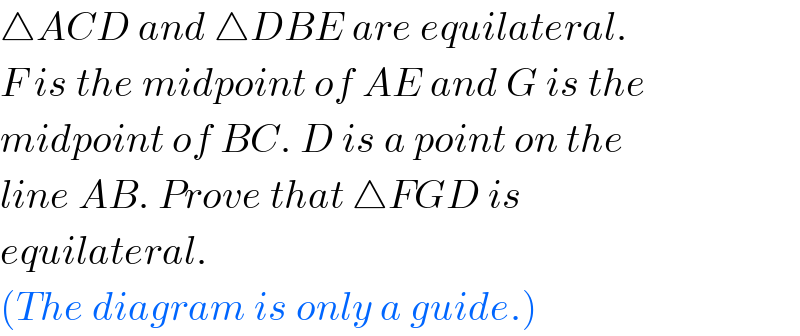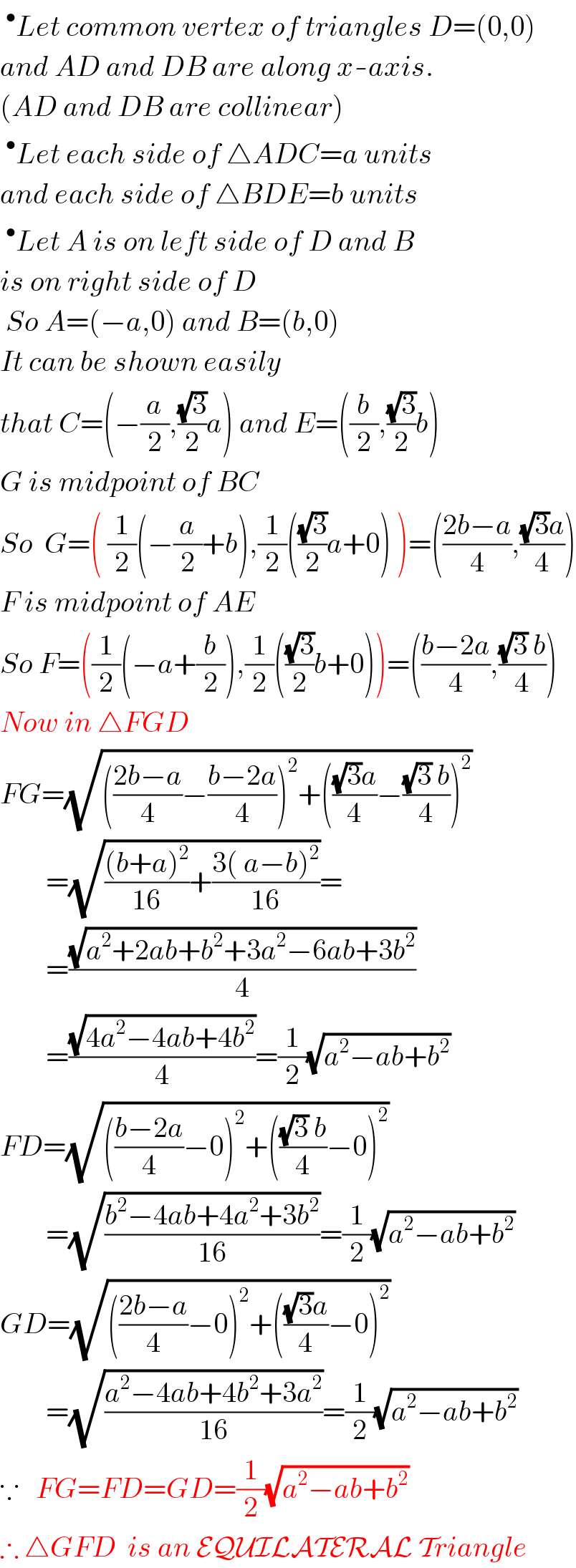
Question Number 4505 by Yozzii last updated on 03/Feb/16

Commented by Yozzii last updated on 03/Feb/16

$$\bigtriangleup{ACD}\:{and}\:\bigtriangleup{DBE}\:{are}\:{equilateral}. \\ $$$${F}\:{is}\:{the}\:{midpoint}\:{of}\:{AE}\:{and}\:{G}\:{is}\:{the} \\ $$$${midpoint}\:{of}\:{BC}.\:{D}\:{is}\:{a}\:{point}\:{on}\:{the} \\ $$$${line}\:{AB}.\:{Prove}\:{that}\:\bigtriangleup{FGD}\:{is}\: \\ $$$${equilateral}.\: \\ $$$$\left({The}\:{diagram}\:{is}\:{only}\:{a}\:{guide}.\right) \\ $$
Answered by Rasheed Soomro last updated on 05/Feb/16

$$\:^{\bullet} {Let}\:{common}\:{vertex}\:{of}\:{triangles}\:{D}=\left(\mathrm{0},\mathrm{0}\right) \\ $$$${and}\:{AD}\:{and}\:{DB}\:{are}\:{along}\:{x}-{axis}. \\ $$$$\left({AD}\:{and}\:{DB}\:{are}\:{collinear}\right) \\ $$$$\:^{\bullet} {Let}\:{each}\:{side}\:{of}\:\bigtriangleup{ADC}={a}\:{units} \\ $$$${and}\:{each}\:{side}\:{of}\:\bigtriangleup{BDE}={b}\:{units} \\ $$$$\:^{\bullet} {Let}\:{A}\:{is}\:{on}\:{left}\:{side}\:{of}\:{D}\:{and}\:{B} \\ $$$${is}\:{on}\:{right}\:{side}\:{of}\:{D} \\ $$$$\:{So}\:{A}=\left(−{a},\mathrm{0}\right)\:{and}\:{B}=\left({b},\mathrm{0}\right) \\ $$$${It}\:{can}\:{be}\:{shown}\:{easily} \\ $$$${that}\:{C}=\left(−\frac{{a}}{\mathrm{2}},\frac{\sqrt{\mathrm{3}}}{\mathrm{2}}{a}\right)\:{and}\:{E}=\left(\frac{{b}}{\mathrm{2}},\frac{\sqrt{\mathrm{3}}}{\mathrm{2}}{b}\right) \\ $$$${G}\:{is}\:{midpoint}\:{of}\:{BC} \\ $$$${So}\:\:{G}=\left(\:\frac{\mathrm{1}}{\mathrm{2}}\left(−\frac{{a}}{\mathrm{2}}+{b}\right),\frac{\mathrm{1}}{\mathrm{2}}\left(\frac{\sqrt{\mathrm{3}}}{\mathrm{2}}{a}+\mathrm{0}\right)\:\right)=\left(\frac{\mathrm{2}{b}−{a}}{\mathrm{4}},\frac{\sqrt{\mathrm{3}}{a}}{\mathrm{4}}\right) \\ $$$${F}\:{is}\:{midpoint}\:{of}\:{AE} \\ $$$${So}\:{F}=\left(\frac{\mathrm{1}}{\mathrm{2}}\left(−{a}+\frac{{b}}{\mathrm{2}}\right),\frac{\mathrm{1}}{\mathrm{2}}\left(\frac{\sqrt{\mathrm{3}}}{\mathrm{2}}{b}+\mathrm{0}\right)\right)=\left(\frac{{b}−\mathrm{2}{a}}{\mathrm{4}},\frac{\sqrt{\mathrm{3}}\:{b}}{\mathrm{4}}\right) \\ $$$${Now}\:{in}\:\bigtriangleup{FGD} \\ $$$${FG}=\sqrt{\left(\frac{\mathrm{2}{b}−{a}}{\mathrm{4}}−\frac{{b}−\mathrm{2}{a}}{\mathrm{4}}\right)^{\mathrm{2}} +\left(\frac{\sqrt{\mathrm{3}}{a}}{\mathrm{4}}−\frac{\sqrt{\mathrm{3}}\:{b}}{\mathrm{4}}\right)^{\mathrm{2}} } \\ $$$$\:\:\:\:\:\:\:\:=\sqrt{\frac{\left({b}+{a}\right)^{\mathrm{2}} }{\mathrm{16}}+\frac{\mathrm{3}\left(\:{a}−{b}\right)^{\mathrm{2}} }{\mathrm{16}}}= \\ $$$$\:\:\:\:\:\:\:\:=\frac{\sqrt{{a}^{\mathrm{2}} +\mathrm{2}{ab}+{b}^{\mathrm{2}} +\mathrm{3}{a}^{\mathrm{2}} −\mathrm{6}{ab}+\mathrm{3}{b}^{\mathrm{2}} }}{\mathrm{4}} \\ $$$$\:\:\:\:\:\:\:\:=\frac{\sqrt{\mathrm{4}{a}^{\mathrm{2}} −\mathrm{4}{ab}+\mathrm{4}{b}^{\mathrm{2}} }}{\mathrm{4}}=\frac{\mathrm{1}}{\mathrm{2}}\sqrt{{a}^{\mathrm{2}} −{ab}+{b}^{\mathrm{2}} } \\ $$$${FD}=\sqrt{\left(\frac{{b}−\mathrm{2}{a}}{\mathrm{4}}−\mathrm{0}\right)^{\mathrm{2}} +\left(\frac{\sqrt{\mathrm{3}}\:{b}}{\mathrm{4}}−\mathrm{0}\right)^{\mathrm{2}} } \\ $$$$\:\:\:\:\:\:\:\:=\sqrt{\frac{{b}^{\mathrm{2}} −\mathrm{4}{ab}+\mathrm{4}{a}^{\mathrm{2}} +\mathrm{3}{b}^{\mathrm{2}} }{\mathrm{16}}}=\frac{\mathrm{1}}{\mathrm{2}}\sqrt{{a}^{\mathrm{2}} −{ab}+{b}^{\mathrm{2}} } \\ $$$${GD}=\sqrt{\left(\frac{\mathrm{2}{b}−{a}}{\mathrm{4}}−\mathrm{0}\right)^{\mathrm{2}} +\left(\frac{\sqrt{\mathrm{3}}{a}}{\mathrm{4}}−\mathrm{0}\right)^{\mathrm{2}} } \\ $$$$\:\:\:\:\:\:\:\:=\sqrt{\frac{{a}^{\mathrm{2}} −\mathrm{4}{ab}+\mathrm{4}{b}^{\mathrm{2}} +\mathrm{3}{a}^{\mathrm{2}} }{\mathrm{16}}}=\frac{\mathrm{1}}{\mathrm{2}}\sqrt{{a}^{\mathrm{2}} −{ab}+{b}^{\mathrm{2}} } \\ $$$$\because\:\:\:{FG}={FD}={GD}=\frac{\mathrm{1}}{\mathrm{2}}\sqrt{{a}^{\mathrm{2}} −{ab}+{b}^{\mathrm{2}} } \\ $$$$\therefore\:\bigtriangleup{GFD}\:\:{is}\:{an}\:\mathcal{EQUILATERAL}\:\mathcal{T}{riangle} \\ $$
Commented by Yozzii last updated on 04/Feb/16

$${Nice}\:{approach}.\:{Is}\:{there}\:{an}\:{answer}\:{that} \\ $$$${uses}\:{only}\:{the}\:{axioms}\:{and}\:{theorems}\:{of} \\ $$$${Euclidean}\:{geometry}? \\ $$
Commented by Rasheed Soomro last updated on 05/Feb/16

$${There}\:{must}\:{be}\:{axiomatic}\:{proof},{but}\:{I}\: \\ $$$${am}\:{not}\:{successful}\:{to}\:{prove}\:{yet}. \\ $$
Commented by Yozzii last updated on 06/Feb/16

$${Yes}.\:{This}\:{area}\:{of}\:{geometry}\:{is}\:{alien}\:{to} \\ $$$${me}. \\ $$
